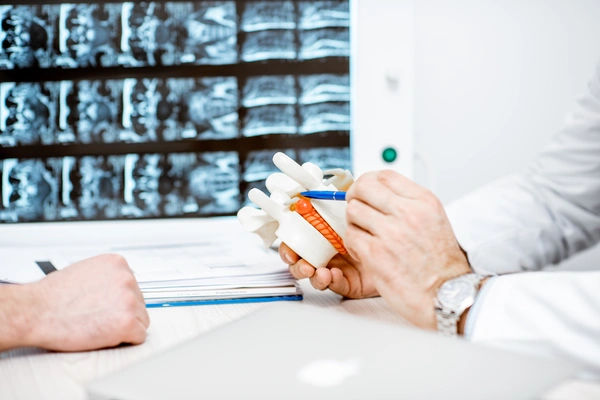Guide to Robotic Surgery Benefit Hernia Patients
Discover how robotic hernia surgery offers precision, less pain, minimal scarring, and faster recovery. Learn about the procedure, benefits, recovery, and candidacy.

Written by Dr. Rohinipriyanka Pondugula
Reviewed by Dr. M L Ezhilarasan MBBS
Last updated on 6th Oct, 2025

Introduction
For decades, the thought of hernia surgery often conjured images of large incisions, significant pain, and a long, restrictive recovery. Today, medical technology has transformed this experience. Robotic surgery is revolutionising hernia repair, offering a minimally invasive path to better health. But what exactly does this mean for you as a patient?
This guide cuts through the technical jargon to provide a clear, comprehensive look at how robotic surgery benefits
hernia patients. We will explore how this advanced technology enhances precision, reduces pain, and accelerates
recovery, helping you make an informed decision about your care. Whether you are considering surgery for an
inguinal, ventral, or hiatal hernia, understanding the advantages of the robotic approach is the first step toward a
smoother journey back to your daily life.
What is Robotic Hernia Surgery, Really?
At its core, robotic hernia surgery is an advanced form of minimally invasive surgery. It is important to clarify a
common misconception: the robot does not perform the surgery on its own. Instead, think of it as a highly sophisticated
tool that extends the surgeon's capabilities. The surgeon controls every movement of the robotic arms from a console
located just feet away from the patient.
The most common system used is the da Vinci Surgical System. It consists of a surgeon’s console, a patient-side cart
with four interactive arms, and a high-definition 3D vision system. Tiny instruments are mounted on these arms and
inserted through small incisions, typically 1–2 centimetres long.
Beyond Science Fiction: The Surgeon is Always in Control
The surgeon sits at the console, peering into a viewer that provides a magnified, high-definition, three-dimensional
image of the inside of your abdomen. This is a significant upgrade from the flat 2D view in standard laparoscopy. The
system seamlessly translates the surgeon’s hand, wrist, and finger movements into precise, scaled, and tremor-filtered
movements of the miniaturised instruments inside your body. The surgeon is in complete control at all times.
Robotic Surgery vs. Laparoscopic Surgery: A Key Distinction
While both are minimally invasive, robotic surgery offers distinct advantages over traditional laparoscopy.
Laparoscopic instruments are rigid and have a limited range of motion, mimicking the straight-line movement of a
chopstick. Robotic instruments, however, have articulated wrists that bend and rotate far greater than the human hand,
allowing the surgeon to suture and place mesh with exceptional accuracy in tight spaces. This enhanced dexterity is a
primary reason for its benefit in complex hernia repairs.
Consult Top Doctors for Personalised Advice
Top 5 Benefits of Choosing Robotic Hernia Repair
The advantages of this technology translate directly into tangible benefits for patients. Here are the top five reasons why
individuals are choosing robotic hernia surgery.
1. Enhanced Precision and Superior Visualisation
The 3D, high-definition camera provides surgeons with an unparalleled view of the hernia defect and surrounding
anatomy, such as blood vessels and nerves. This allows for meticulous dissection and more precise placement of the
surgical mesh, which is critical for a strong, durable repair. The enhanced precision of robotic inguinal hernia repair can
lead to better preservation of healthy tissue.
2. Less Pain and Minimal Scarring
Because the procedure is performed through a few small incisions instead of one large one, patients typically experience
significantly less postoperative pain and require fewer pain medications. This also results in minimal scarring, often just
a few tiny marks that fade over time, which is a major cosmetic benefit.
3. A Faster Recovery and Shorter Hospital Stay
With less tissue trauma and pain, many patients can go home the same day or after a very short hospital stay. They can
return to light activities, such as desk work and driving, within days rather than weeks. The recovery time after robotic
hernia repair is generally much quicker compared to open surgery.
4. Reduced Risk of Complications and Infection
Smaller incisions mean a lower risk of surgical site infections. The precision of the robotic system also helps minimise
the risk of injury to surrounding tissues, nerves, and blood vessels, which can lead to fewer complications such as chronic groin pain after inguinal hernia repair or bleeding.
5. Ideal for Complex and Recurrent Hernias
For large ventral hernias, hernias in difficult locations, or hernias that have come back after a previous repair, robotic surgery is particularly beneficial. The technology gives surgeons the tools needed to navigate scar tissue from past surgeries and perform a more effective reconstruction of the abdominal wall, potentially lowering the chance of another recurrence.
Are You a Candidate for Robotic Hernia Repair?
While robotic surgery offers numerous advantages, it is not the only option. The best candidate for robotic hernia
surgery is typically determined by a surgeon after a thorough evaluation. Factors include:
- The type, size, and location of your hernia
- Your overall health and medical history, such as obesity or previous abdominal surgeries
- Whether the hernia is a first-time occurrence or a recurrence
In many cases, robotic surgery is an excellent option for most types of hernias. However, very small or uncomplicated
hernias might be effectively treated with open or laparoscopic techniques. Consultation with a surgeon experienced in all approaches is essential to determine the best path for you. If you have a hernia and are exploring surgical options,
you can consult a surgeon online with Apollo24|7 to discuss your specific case.
What to Expect: The Robotic Hernia Surgery Journey
Understanding the process can alleviate anxiety. Here is a general roadmap.
Before the Procedure: Consultation and Preparation
Your journey begins with a detailed consultation where your surgeon will explain the procedure, discuss risks and
benefits, and order any necessary pre-operative tests. You will receive instructions on medications, fasting, and other
preparations.
The Day of Surgery: A Step-by-Step Walkthrough
On the day of surgery, you will receive anaesthesia. The surgical team will position you and the robotic system. The
surgeon will then make the small incisions, insert the ports for the camera and instruments, and begin the repair from
the console. The hernia is reduced, and a mesh is typically placed to reinforce the weakened area.
The Recovery Roadmap: From Hospital to Home
After surgery, you will wake up in a recovery area. Many patients are able to leave the hospital the same day. You will
be given specific instructions on wound care, pain management, and activity restrictions. Most people can resume
normal non-strenuous activities within 1–2 weeks, but heavy lifting should be avoided for 4–6 weeks as directed by your
surgeon.
Addressing Common Concerns: Cost, Safety, and Results
It is natural to have questions about the safety, cost, and expected outcomes of robotic hernia surgery; this section
addresses the most common concerns to help you make an informed decision.
A. Is Robotic Hernia Surgery Safe?
Extensive clinical studies have demonstrated that robotic hernia surgery is as safe as, and in some cases safer than,
traditional approaches when performed by a trained surgeon. The enhanced visualisation and control contribute to this
safety profile.
B. Understanding the Cost and Insurance Landscape
The cost of robotic hernia surgery can be higher than that of laparoscopic or open surgery due to the technology involved. However, it is important to consider the overall value. A faster recovery can mean less time off work and lower indirect costs. Most major insurance companies, including Medicare, cover robotic hernia surgery when it is
deemed medically necessary. It is crucial to verify coverage with your provider beforehand.
Conclusion: Is Robotic Surgery the Right Choice for Your Hernia?
Robotic hernia surgery represents a significant leap forward in patient care. By combining the benefits of minimally
invasive techniques with advanced technology, it offers a path to repair that is defined by greater precision, less pain,
and a faster return to normal life. While it may not be suitable for everyone, its advantages for a wide range of hernia
types are clear.
The decision ultimately depends on your individual condition and having an open conversation with a qualified surgeon. If you are living with a hernia, exploring the option of robotic repair could be the key to a more comfortable and efficient recovery. Take the next step by booking a visit to a surgeon with Apollo24|7 to get a personalised evaluation and discuss if this advanced approach is right for you.
Consult Top General Surgeons
Consult Top General Surgeons

Dr. Vidya Konduri
Obstetrician and Gynaecologist
9 Years • MS
Chinagadila
Apollo Hospitals Health City Unit, Chinagadila
(50+ Patients)

Dr Syamal Kumar Sarkar
General and Laparoscopic Surgeon
40 Years • MBBS(Cal),MS (Gen.Surg.)(Cal)
Kolkata
Apollo Multispeciality Hospitals , Kolkata, Kolkata

Dr Agasthya Dharmapuri
General and Laparoscopic Surgeon
10 Years • MBBS, MS(General Surgery), FMAS
Arepally
APOLLO REACH NSR HOSPITALS, Arepally

Dr. Sunil Kaul
General Surgeon
30 Years • MBBS, MS, FICS, FIMSA, FMAS
Delhi
Apollo Hospitals Indraprastha, Delhi
(25+ Patients)

Dr. C R K Prasad
General and Laparoscopic Surgeon
28 Years • MBBS, MS, FAIS, FMAS, FIAGES
Hyderguda
Apollo Hospitals Hyderguda, Hyderguda
Consult Top Doctors for Personalised Advice

Dr. Vidya Konduri
Obstetrician and Gynaecologist
9 Years • MS
Chinagadila
Apollo Hospitals Health City Unit, Chinagadila
(50+ Patients)

Dr Syamal Kumar Sarkar
General and Laparoscopic Surgeon
40 Years • MBBS(Cal),MS (Gen.Surg.)(Cal)
Kolkata
Apollo Multispeciality Hospitals , Kolkata, Kolkata

Dr Agasthya Dharmapuri
General and Laparoscopic Surgeon
10 Years • MBBS, MS(General Surgery), FMAS
Arepally
APOLLO REACH NSR HOSPITALS, Arepally

Dr. Sunil Kaul
General Surgeon
30 Years • MBBS, MS, FICS, FIMSA, FMAS
Delhi
Apollo Hospitals Indraprastha, Delhi
(25+ Patients)

Dr. C R K Prasad
General and Laparoscopic Surgeon
28 Years • MBBS, MS, FAIS, FMAS, FIAGES
Hyderguda
Apollo Hospitals Hyderguda, Hyderguda
More articles from Hernia
Frequently Asked Questions
Q1. How long does robotic hernia surgery take?
The surgery itself typically takes between 1 to 2 hours, depending on the complexity and size of the hernia. This is often comparable to laparoscopic surgery but can be more efficient for complex repairs.
Q2. What is the success rate of robotic hernia surgery?
Success rates are very high, often exceeding 95% for primary repairs. For complex or recurrent hernias, robotic surgery can offer success rates superior to open surgery due to its precision and ability to navigate scar tissue.
Q3. Will I have a mesh implant with robotic surgery?
In the vast majority of cases, yes. Mesh reinforcement is the standard of care for most hernia repairs as it significantly reduces the risk of the hernia returning. The robotic approach allows for optimal mesh placement and fixation.
Q4. Is the pain after robotic surgery manageable?
Yes. Most patients report that pain is well-controlled with oral pain medication for just a few days. The pain is generally much less intense than after traditional open surgery.
Q5. When can I start exercising again after robotic hernia repair?
You can usually start light walking immediately after surgery. Strenuous activities, heavy lifting, and core-intensive exercises like weightlifting or running should be avoided for 4–6 weeks, as advised by your surgeon.



.webp)
